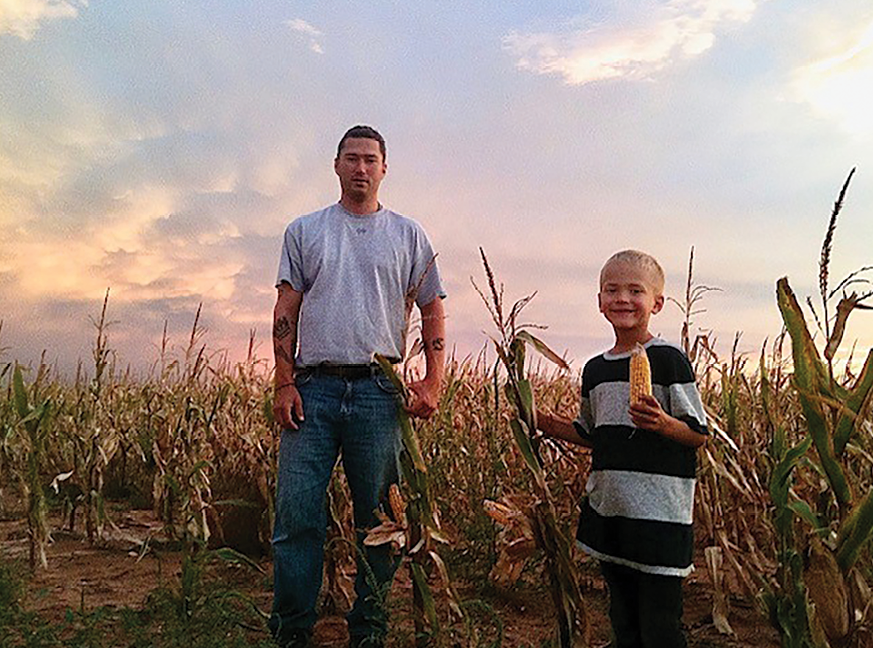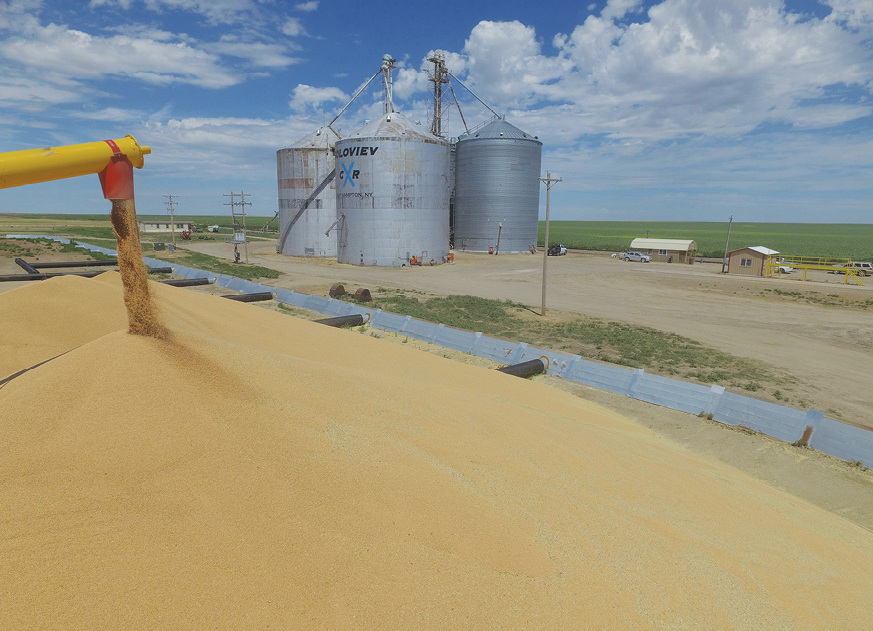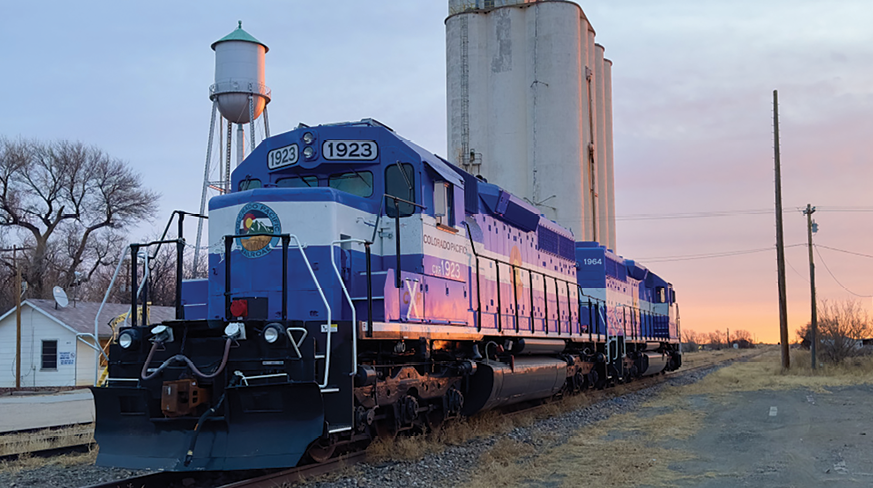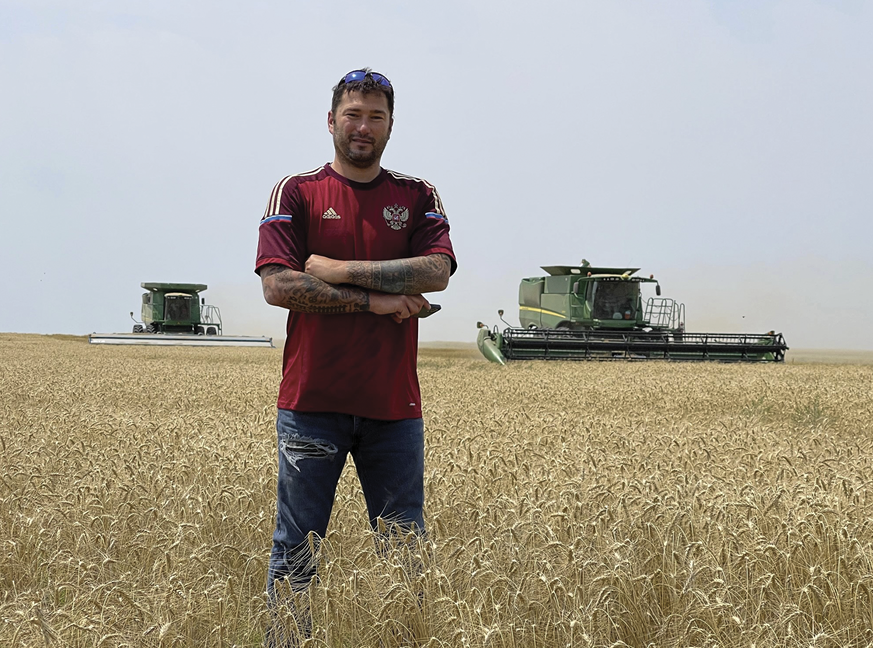- Home
- Media Kit
- MediaJet
- Current Issue
- Past Issues
- Ad Specs-Submission
- Ad Print Settings
- Reprints (PDF)
- Photo Specifications (PDF)
- Contact Us
![]()
ONLINE
![]()
ONLINE

Farming for the Future
Editors’ Note
Stefan Soloviev is Chairman of Soloviev Group (solovievgroup.com), a privately held eight-region, billion-dollar company involved in agribusiness, logistics, renewable energy, and real estate. It is the 26th largest landowner in the U.S. with agricultural operations in Colorado, Kansas, and New Mexico. Its agribusiness group, Crossroads Agriculture, farms 500,000 acres growing corn, wheat, milo, and alfalfa, and also raises cattle.

Stefan Soloviev and son, Quintin, in a Crossroads Agriculture
dryland corn field outside of Portales, New Mexico in 2010
You grew up in New York City, at age 11 taking the M15 bus down Second Avenue and up First Avenue to school and back. How did you wind up in farming?
When I was 14, I started trading stocks and commodities. It had nothing to do with agriculture. I would watch CNBC when I got home from school each afternoon. My interest grew and a trader offered to take me to visit the trading floor of the New York Mercantile Exchange (NYMEX). It was phenomenal. It was different back then, like the movie Trading Places – a lot of hand signals, paper, and action, with less electronic trading. I knew at 14 it was for me.
What happened next?
In my early 20s, after one of many falling outs I had with my father, I walked out, changed my last name, moved to Phoenix with my wife and started trading commodities. I started out in sugar. I really don’t know why, but then I got into currencies, gold, platinum, and other metals and, for reasons I can’t exactly pinpoint, I wound up in the grain markets.
I still love trading. Commodities/Futures are totally different and are more difficult and intricate than equities. Anyone can trade equities, but futures trading has its own language and crazy hours. You could find yourself talking to a person at 3:00 AM and throwing out month abbreviations that have become part of your vocabulary. There are totally different variables, not only just the price but also the length of the contract and whether there is an inversion. Then you have to figure out if you can take advantage of the inversion. Leverage is another issue. For example, one contract of wheat is 5,000 bushels. If the price of wheat is $7 a bushel, then your contract is obviously worth $35,000, but it takes a lot less than $35,000 to control that amount of wheat which of course makes it much more advantageous and dangerous at the same time. It’s a totally different game than equities. It’s easy to hit home runs but, at the same time, it’s also easier to get blown out of a trade. As I said, anyone can trade equities, but probably less than 1 percent of people who trade equities are cut out for the futures market.

An open ground pile of wheat in Astor, Kansas.
Crossroads Agriculture is building more indoor storage capacity
and improving logistics to get farmers’ crops to market.
When did you know that you wanted to own farmland?
Back around 2000, I realized that some commodities, especially grain prices, were not keeping up with inflation. Even though inflation was historically low at the time, I knew grain was going to become more expensive. You could go back 30 or 40 years on the price of wheat, for example, and there was no real change in price other than select times during specific world events. I quickly shifted from not only wanting to trade grains, but also to own farmland – which at the time was totally out of favor – and produce grains. My wife at the time and I started traveling to Wichita and immersed ourselves in the community. It was a culture shock, but a good one, and a needed one. We first met a land broker who was also a farmer which led to introductions to other farmers who, at first, were taken aback by my being from New York City but, when they got to know us, they were so helpful, taking us around for days at a time and explaining different wheat varieties, and basically how real farming works. People think of farmers as people who have a red barn, chickens, and a tractor. You learn very quickly that if you’re a wheat producer on the Great Plains, you don’t have time for the relaxed life people envision farmers enjoying and that this is an incorrect stereotype. You have to go around and farm your land comprised of vast empty fields, usually ranging between 40 and 640 acres which is a full square mile of land. You need to be efficient given where your land is and in how you move your equipment around, in where and how you get your inputs, and in where your market is.
I eventually bought 309 acres south of Wichita and planted milo, a type of sorghum that tracks the price of corn. It’s non-GMO, so China can be a huge buyer of it (some years depending on international relations among other things). When China is buying, you can basically add a $1 basis on top of the price of corn. Milo is easier to grow than corn and is also more drought tolerant than corn. Milo plays much more into what I’m doing and where I’m located today than it did back in the Wichita days.
How did you initially know how to grow and harvest it?
I had a farmer or two who helped me, but I did most of the work myself. It was a mess for the first year, but it kind of needed to be and I remember it being a lot of fun.

Crossroads Agriculture’s Colorado Pacific Railroad
and grain silos
How did your focus and commitment to sustainability develop?
It really grew out of what I perceived to be a great business opportunity. Drought-resistant corn seed had come a long way by the early 2000s. It allowed corn to be grown in dryland areas where it couldn’t really grow 10 years prior. So, after a couple of years in Wichita and then western Nebraska, I finally settled on the Kansas/Colorado border which was a place I felt would be perfect for expansion. It was an area where no one was looking for land. You would barely see anyone from Denver or Iowa looking to take a shot there, much less any investors from the big cities. Less rainfall meant more risk, but also meant much larger fields at cheaper prices than the fields around Wichita. In my mind, it was also a prime area not only for the westward expansion of the drought-resistant corn, but for newer technologies for tomorrow. The plan was simple – leverage as much land as possible through farm credit. Then, as the grain price started to go the way I thought it would, the price of the acreage – as low as $200 an acre back then – would follow and allow more equity for more land.
Why do you prefer dryland farming?
The beauty and perils of dryland farming are that you only rely on rain, which is more and more important the farther west you go, which leads to one of the most important issues in agriculture in the West – water. The fact is that in many parts of the West, overuse of water for irrigation of crops has seriously depleted the underlying aquifers. Some states, like Kansas and Colorado, are trying to manage the use of water for irrigated fields, cutting use by some 20 percent these days. States like Oklahoma, Texas, and New Mexico are still not limiting use which is creating serious problems both now and for the future. Not all irrigated land can be turned to dryland, so a lot of it is just going to disappear and become grassland.
“Another reason I selected the area I did was that it is located in some of the windiest parts of North America. A wind turbine only takes up less than two acres and they are cash producers, and it is easy to farm around them. We currently have more than 30 wind turbines in service in New Mexico, and construction will soon commence on 40 wind turbines on our farmland in Colorado. By 2027, we expect to have at least 250 wind turbines in each of those states.”
How is Crossroads Agriculture addressing water conservation?
We own about 40 circles (center pivot sprinklers watering 125 of the 160 acres per pivot). Most of that land is in alfalfa and we are managing our water carefully, as are our neighbors. One day, we may have to switch some circles to triticale, a forage that takes less water to grow.
We are mostly a dryland operation. We are engaged in what is called no-till and minimum-till farming. We are in an area where we will average 15-20 inches of rain a year. Every time you plow a field, you lose an inch of moisture. If you run a plow through a field five times a year, you can pretty much guarantee you are losing about a third of your moisture which no one can afford to do in our area since we are so far west. With no-till and minimum-till farming, you leave the stubble from the previous year’s crop in the ground, which in turn keeps the moisture in the ground. If you do nothing to the fields, weeds grow and suck away your moisture anyway, so spraying is the only way to control weeds today and allow the moisture we naturally get every year to remain in the ground. Technology in farming has come such a long way and I will say that the future right now has never looked better for agriculture. I’m pretty sure that in the next 10-20 years, technology will find a way to eliminate weeds without spraying.

Stefan Soloviev in a Crossroads Agriculture wheat field
Do you grow organic food?
Yes, we have about 10,000 acres in Colorado dedicated to organic wheat. People who live in urban areas don’t realize that organic farms can’t grow crops successfully enough today to feed the world, or even a quarter of it, without providing plants with nutrients and preventing weed growth. As I said, I believe technology will evolve to the point where we don’t need chemicals, but for now they are essential. I have been in this business long enough to know that the term “organic” is a loaded word. I’m not going to go too far into that now, but let’s just say it sure isn’t what they want you to think it is. I’ll address that issue at a later time.
Crossroads Agriculture is a leader in using its farmlands for sustainable energy projects. Will you highlight this focus?
I was very fortunate to buy farmland for pennies compared to what it would have cost today. I was in this industry way before people like Bill Gates and Jeff Bezos thought about buying farmland. Another reason I selected the area I did was that it is located in some of the windiest parts of North America. A wind turbine only takes up less than two acres and they are cash producers, and it is easy to farm around them. We currently have more than 30 wind turbines in service in New Mexico, and construction will soon commence on 40 wind turbines on our farmland in Colorado. By 2027, we expect to have at least 250 wind turbines in each of those states. We essentially have become e-farmers as well as traditional farmers, harvesting electrons as well as grains. We also are planning a large-scale solar operation on more than 8,000 acres of land in Eastern Colorado that will produce one gigawatt of power, enough to provide electricity to 250,000 homes.
What other major projects is Soloviev Group looking at?
Crossroads is in discussions with the Canadian government for what would be one of the world’s largest hydroponic farms covering several hundred acres indoors. Canada has a very short planting and growing season, and a large percentage of its specialty crops have to be imported from outside Canada. The facility will allow Canadians to have homegrown lettuce, strawberries, and other specialty crops that cannot be efficiently grown in their country. Most importantly, the project is incredibly sustainable. While hydroponics consume significant amounts of energy, 94 percent of Quebec’s electricity comes from hydroelectric plants, and the water used is completely recyclable.
Crossroads Agriculture now owns rail lines, has built an 8-million-bushel grain elevator, and is continuing to improve the logistics for farmers in its area of operations. Is this part of your sustainability initiatives?
Yes, in the sense it helps neighboring farm communities get their crops to market more efficiently. I should also note that we now give farmers another option to get their grain to different markets and even export internationally if in the years ahead that makes sense to do. As a farmer myself, it is important to maximize the price we get given the hard work it takes to go through an entire growing season. As I said from the beginning, farmers have been very good to me. I was a kid from New York City with zero education on agriculture production. Everything I learned, I learned from the farmers, not from a university. I hope that building the 8-million-bushel WesKan Grain facility, saving a rail line that’s now the Colorado Pacific, and setting up a direct unit train (110 cars) shooting west will be something I can give back to them in return.![]()